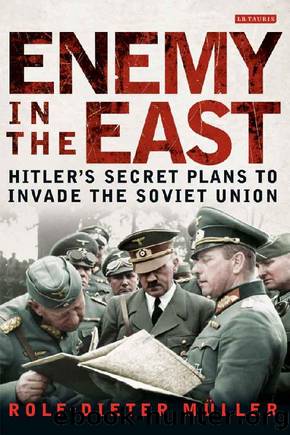Enemy in the East by Rolf-Dieter Müller

Author:Rolf-Dieter Müller [Müller, Rolf-Dieter]
Language: eng
Format: epub
Tags: Poland, Military History, Europe, Espionage and secret service, Soviet Union, Germany, Operation Barbarossa, Nazism, Fascism, Hitler, History, Red Army, Battles and campaigns, Second World War
Publisher: I.B.Tauris
Published: 2014-12-03T08:00:00+00:00
17. German and Soviet soldiers at the joint victory parade in Brest-Litovsk, 22 September 1939.
In the first week of the campaign, the troops of Army Group North also made a rapid advance.16 Alongside the 3rd Army in East Prussia, this included the Pomeranian 4th Army, which was to occupy the Corridor and secure the link to East Prussia. It was then to support the advance of the 3rd Army from the east bank of the Vistula. Fedor von Bock, the commander-in-chief of Army Group North, managed on 5 September to gain acceptance for his idea of forming a second eastern wing. This would advance towards Brest-Litovsk and Lublin to enable the Germans to encircle any enemy troops gathering in central Poland. At this point, it was still wholly unclear whether the Red Army would intervene on the side of the Wehrmacht. To make the advance work, the army group was given permission to take the motorised forces of the 4th Army, which had just broken through the Corridor, out of the line and move them behind the 3rd Army to the area around Giżycko. These motorised forces were in fact the XIX Army Corps under Heinz Guderian, the âcreator of the German tank forceâ. With his two motorised infantry divisions and an armoured division, he proceeded to give an exemplary demonstration of the potential for rapid and far-ranging operational movement â something for which the Germans had lacked the confidence during Halderâs war game in May. Guderian and his corps had reached the Vistula from Pomerania within a few days, then liberated Danzig and been transported more than 120 miles to Giżycko, from where they advanced nearly 180 miles behind the Polish front, travelling on the eastern bank of the Bug via Brest-Litovsk to WÅodawa. While the battle for Warsaw was being fought, he and his forces covered the 3rd Army from the east until the Red Army arrived. By conquering the area between the Narew and the Bug, Guderian had secured the projected northern avenue of advance right up to the Pripet Marshes, which â in both World War I and the military plans of the 1930s â had been considered the point of departure for an attack on the Baltic states and the Russian heartland. History does not record what Guderian was thinking during the subsequent joint GermanâRussian parade to mark the handover of that area to the Soviet armoured divisions. In any case, he and his troops withdrew from a part of Poland to which he would turn his attention again almost exactly a year later, when he took on an important role in the planning and preparation for Barbarossa.
On the projected southern avenue, the 14th Army had advanced via Krakow towards the Ukraine, crossing the San and reaching the Bug within a fortnight. The right flank (i.e. the southernmost German group) was made up of the XVIII Army Corps. Because of the terrain, the partly motorised corps included a mountain division. Together with the Slovakian Army
Download
This site does not store any files on its server. We only index and link to content provided by other sites. Please contact the content providers to delete copyright contents if any and email us, we'll remove relevant links or contents immediately.
| Africa | Americas |
| Arctic & Antarctica | Asia |
| Australia & Oceania | Europe |
| Middle East | Russia |
| United States | World |
| Ancient Civilizations | Military |
| Historical Study & Educational Resources |
The Battle of Mogadishu by Matt Eversmann & Dan Schilling(612)
The Confidence Men by Margalit Fox(535)
The Spymaster of Baghdad by Margaret Coker(533)
A History of the Muslim World since 1260: The Making of a Global Community by Vernon O. Egger(516)
Jack the Ripper and the East End by Peter Ackroyd(472)
Empire of Fear: Inside the Islamic State by Andrew Hosken(465)
Islam At The Gates: How Christendom Defeated the Ottoman Turks by Diane Moczar(460)
The Crimean War by Winfried Baumgart(460)
The Afghanistan File by Prince Turki AlFaisal Al Saud(456)
The Jerusalem Diamond by Noah Gordon(454)
Akhenaten by Dominic Montserrat(442)
A Concise History of Greece (Cambridge Concise Histories) by Richard Clogg(441)
Israel: Ancient Kingdom or Late Invention? by Daniel I. Block(439)
The History of Jihad by Robert Spencer(430)
Enemy in the East by Rolf-Dieter Müller(428)
The Privatization of Israeli Security by Shir Hever(425)
Destroying a Nation: The Civil War in Syria by Nikolaos van Dam(424)
The Nine Lives of Pakistan by Declan WALSH(416)
The Dirty War in Kashmir by Shujaat Bukhari(404)
